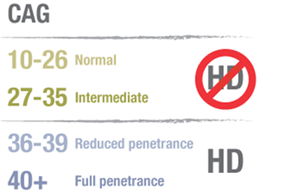HD Research Vocabulary
For a very thorough glossary, visit HDBuzz
Biomarkers: characteristics of the body that can be measured. In Huntington’s disease this can be found through blood, cerebral spinal fluid, MRI, and thinking tests.
CAG repeat: the DNA sequence Cytosine, Adenine, Guanine on the huntingtin gene that causes Huntington’s disease when expanded (repeated more than usual).
CAP score: the “CAG-age-product” equation used to determine eligibility for participation in many clinical trials for HD. Due to the relationship between CAG repeat number and age, this score indicates a person’s likely disease burden. How to calculate a CAP score
Control participants: research volunteers who are not at-risk for Huntington’s disease, or who do not receive a clinical trial treatment. The data they provide is compared to the data from research volunteers who are gene positive for HD or receiving treatment. This allows the researchers to better understand the impact of the disease or treatment.

Gene status: what one knows about their HD genetic information. Most clinical trials include only participants who are gene positive.
- Gene negative: CAG level less than 27
- Gene positive: CAG level of 40 or more
- Intermediate: CAG level 27-35
- Reduced penetrance: CAG level 36-39
- At-risk: those with a parent or grandparent who has HD or is gene positive, and who do not know their gene status
Huntingtin gene (HTT): a gene inherited by all mammals and believed to be necessary for neuronal (nerve cell) development. It’s found throughout the body, and most present in the brain. It provides instructions for the body to make huntingtin protein.
Everyone receives a copy of the huntingtin gene from each parent. People with HD typically receive one expanded HTT from their parent with the disease, and a “normal” HTT from the other parent. The number of repeats in the expanded HTT gene often determines how early the symptoms of Huntington’s disease will appear.
- Mutant HTT: the rare version of the huntingtin gene that has expanded, and causes Huntington’s disease.
- Wild-type HTT: the typical, most common, or “normal” form of the huntingtin gene that everyone has.
Huntingtin lowering: many current clinical trials for HD aim to reduce the amount of huntingtin protein, with a hypothesis that this will reduce symptoms and/or slow disease progression.
Huntingtin protein: what is produced by the huntingtin gene (HTT). When overproduced by the expanded HTT, it becomes toxic and causes Huntington’s disease symptoms.
Huntingtin protein is a biomarker for HD, and can be measured in cerebral spinal fluid from a lumbar puncture.
Open-label extension: study drug is provided to all participants, after some received only placebo, and data continues to be collected.
Screening: process by which the research team collects information from a research volunteer to understand whether they meet the participation requirements of a study.